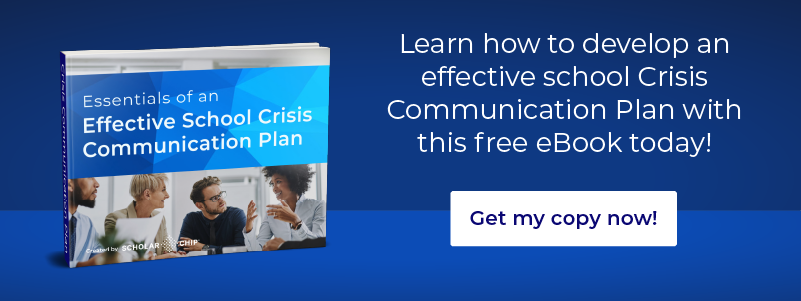In the spring of 2020, as COVID-19 swept through New York, Governor Andrew Cuomo updated citizens with daily live-streamed press briefings. He issued executive orders to close non-essential businesses, playgrounds, and parks. He also banned large social gatherings and mandated mask-wearing in public when social distancing could not be maintained. Cuomo recognized that these measures were unpopular. “I can’t make 19 million people wear masks,” he said, but he believed that if he shared the data that informed his decisions, New Yorkers would willingly comply. Indeed, most New Yorkers understood the situation and followed the rules. As a result, New York brought the virus under control, and the state was able to eventually reopen.
Successful leaders gain trust and support with transparency and clear communications. While school district leaders will not have the national press coverage that Cuomo employed, they can strive for the same effect with crisis communication strategies that identify the people, the procedures, and the technology needed to keep all stakeholders informed during each stage of an emergency management cycle.
Legacy Systems Present Communication Challenges
School IT systems are often pieced together over many years as technology changes and funds are made available for upgrades. The problem inherent with legacy programs is the inability of older systems to share data. For example, while student information databases may store current contact information, attendance is usually recorded in a separate system. In an emergency, determining which students are in what building and matching their names with contact information requires manually cross-referencing two data sets. Outdated systems tend to have less intuitive interfaces, further muddling the situation. Districts that adopt the newest technologies will be able to create a strong communication network that brings all relevant information together in one place.
Additionally, advances in mobile technology have changed the way that people communicate and get their information. Older systems that rely on the US Postal Service, broadcast radio, and landlines may only reach a fraction of the school community. While these modes of communication are still important, modern crisis communication strategies must consider how people are currently using technology to stay informed.
Crisis Communication Strategies for Seamless Communications
Identify Stakeholders
The school community includes people within the school—administrators, faculty, staff, and students—and those outside—parents, first responders, local officials, and the public. A district’s communication team will ideally have a representative from each group, with a district-level administrator assigned the role of media liaison to issue press statements. Districts must establish communication protocols with first responders and various local officials, such those as for health departments, to ensure unimpeded communications during an emergency.
Expand Modes of Communication
Traditional ways of communicating with parents and the community, such as sending home notices with students or mailing newsletters to district residents, are useful for keeping the community informed of new emergency protocols and procedures, but they are less effective when a situation is urgent. Updated communication plans should consider automated phone and email messaging, SMS messaging, and social media posts as additional ways to reach parents and others in the community that need immediate information. Internal systems, such as intercoms and two-way radios, should be assessed for their expediency. Mobile phones and instant messaging expand the options for keeping administrators, faculty, and staff informed during a crisis.
Use Social Media to Engage the Community
“It’s important to communicate in the way people communicate these days,” says Ann Levett, a school superintendent who served on the social media panel at AASA’s 2020 National Conference, “and they rely on social media for a lot of the information they receive.”
Facebook and Twitter are where many people go for real-time information. Conference panelists also point to social media’s usefulness at building relationships before a crisis. The transparency and sense of community created through social media interactions strengthen the public’s trust in school leadership. Social media can create problems, particularly when a platform is used to spread misinformation or negativity, but with policies and training in place, districts can avoid such issues.
Integrate IT
Successful crisis communication strategies align technology and data with the people who need information during all phases of the emergency management cycle. Administration systems carry critical contact data (phone numbers, email addresses, etc.), yet this is only part of the information needed to reach stakeholders during a crisis. Communication coordinators need to know who is in the building and who is not—information that is usually found in attendance programs and visitor logs. Automated attendance and visitor management systems integrated with SIS and administration software provide real-time data for effective crisis communication.
Select Communication Methods for Reliability and Efficiency
Different emergencies call for different modes of communication. PA announcements and fire alarms are suitable for quick evacuations, while lock-down and shelter-in-place situations call for more discreet methods. Internal communications may require different devices than messages sent out into the community. Emergency planning must consider possible crises and the best way to communicate for each situation. Back-up plans are essential. Off-site, remotely accessible data storage will secure systems in the event that a crisis creates power outages or damage to school servers.
Establish a Command Center
All internal communications should be coordinated at the district level, with responsibilities flowing down to individual school buildings. External communications may flow directly from the district’s central offices, with alerts to first responders automated as much as the capabilities of local law enforcement and emergency services allow. With integrated IT, the person tasked with coordinating crisis communications can access school systems via an administration hub to ensure that procedures are properly implemented and all stakeholders are promptly informed of unfolding situations.
In times of crisis, a school leader’s instinct may be to prioritize communications with school decision-makers and first responders. Notifying the remainder of the school community is often considered secondary. However, in the age of hyperconnectivity, where most students own a cell phone, this can create confusion and panic. Imagine a developing emergency in which students inside a building are sending inaccurate messages home. Crisis communication strategies must strive for comprehensive communication systems that will reach all stakeholders, internal and external, and be the first to provide information to ensure accuracy. Upgraded IT systems can streamline all of a district’s operations and improve communication capabilities not only during a crisis but also throughout the normal course of the school year.
Here at ScholarChip, we’re dedicated to helping school leaders maximize the safety and well-being of students and the entire school community.
Want to develop an effective school crisis communication plan but not sure where to start? Feel free to chat with one of our school crisis communication specialists today!


